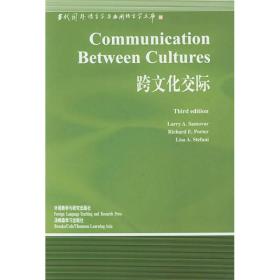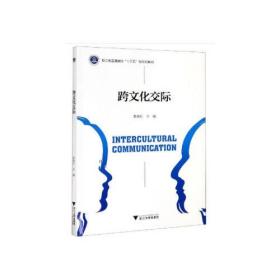
跨文化交际
全新正版 急速发货
¥ 63.1 7.1折 ¥ 89 全新
库存4件
作者迟红
出版社知识产权出版社
ISBN9787513081016
出版时间2022-09
装帧平装
开本16开
定价89元
货号29467628
上书时间2024-11-23
- 在售商品 暂无
- 平均发货时间 14小时
- 好评率 暂无
- 最新上架
商品详情
- 品相描述:全新
- 商品描述
-
前言
跨文化交际课程于2019年在中国大学慕课平台成功上线,选课人数超过万人。本教材是在慕课课件的基础上,根据教*部颁布的《大学英语教学指南》编写而成的。语言是文化的载体,同时也是文化的重要组成部分,学生学习英语这一交流工具,除了学习、交流先进的科学技术和专业信息,还要了解国外的社会与文化,增进对不同文化的理解、对中外文化异同的认识,培养跨文化交际能力。人文性的核心是以人为本,弘扬人的价值,注重人的综合素质培养和全面发展,应将社会主义核心价值观有机地融入大学英语教学中。因此,要充分挖掘大学英语课程丰富的人文内涵,实现工具性和人文性的有机统一。
本教材以培养具有“家国情怀,国际视野”的高素质人才为己任,在借鉴国内外优秀教材的基础上:一方面选取具有代表性的英语国家的主流文化现象进行描述、阐释和讨论;另一方面有机地融入了中国传统文化,帮助学生掌握必要的跨文化交际知识,培养学生对目的语文化的兴趣和理解力,同时引导学生对中西方文化进行主动观察、分析比较,从而拓宽国际视野,增强跨文化交际意识,提高跨文化交际能力。
本教材由9章构成,围绕什么是文化、文化的特征、语言与文化的关系、跨文化交际的历史发展、跨文化交际的障碍以及如何培养跨文化交际能力等内容展开。
每章均有导读,设定教学目标,根据主题配有预热练习,并以图片、话题讨论等形式来设置练习。按照慕课讲授形式分为课前、课中、课后三个环节展开:一种是基于学生掌握的基本理论;另一种是讨论式的,学生通过头脑风暴、小组讨论、小组展示等方式来完成。为便于学生掌握章节内容,我们在每一节后面都列出了重点词汇,并对课文中提到的重要人物及代表作予以介绍。案例分析之后配有阅读材料,帮助学生在中西方文化对比中培养思辨能力。
课后练习是对课上所学内容的巩固和提高。我们设计了单选题、填空题、判断对错题、阅读题和翻译题,旨在进一步夯实学生的语言基础,同时帮助学生在实践中学会运用单元所学的重点知识。本教材是跨文化交际教学团队集体研究成果,由各位参与者共同完成。具体分工如下:迟红负责全书的设计、统稿,并撰写了前言和第1~3章;姜君负责第4章;封婧超负责第5章;彭慧负责第6章;韩杨负责第7章;石文静负责第8章;苗苗负责第9章。
本教材为北京联合大学2020年资助出版的教材。此外,本教材还配有附录、课后练习的答案,供教师和学生参考使用。
导语摘要《跨文化交际》是一门通识教育课程,它以培养学生的跨文化交际意识,帮助学生了解中西文化差异,并能够在文化碰撞中学会运用跨文化交际理论保持理性和包容,为提高学生的社会语言能力和跨文化交际能力搭建脚手架。该课程中讲授的是通用的一般性理论知识和技能,例如:什么是跨文化交际、交际、文化与交际的关系、文化价值观与文化模式、言语交际、非言语交际、跨文化交际障碍、跨文化交际适应以及跨文化交际能力等。学习这些理论和知识有助于培养学生树立世界眼光、培养国际视野、提高人文素养。批判性思维和科学思维的培养也是该课程的主要目标之一,因此它适合所有的大学本科学生或研究生以及打算出国读本科的高中生来学习。
商品简介《跨文化交际》是一门通识教育课程,它以培养学生的跨文化交际意识,帮助学生了解中西文化差异,并能够在文化碰撞中学会运用跨文化交际理论保持理性和包容,为提高学生的社会语言能力和跨文化交际能力搭建脚手架。该课程中讲授的是通用的一般性理论知识和技能,例如:什么是跨文化交际、交际、文化与交际的关系、文化价值观与文化模式、言语交际、非言语交际、跨文化交际障碍、跨文化交际适应以及跨文化交际能力等。学习这些理论和知识有助于培养学生树立世界眼光、培养国际视野、提高人文素养。批判性思维和科学思维的培养也是该课程的主要目标之一,因此它适合所有的大学本科学生或研究生以及打算出国读本科的高中生来学习。
作者简介迟红,副教授,北京市大学英语研究会理事,新西兰怀卡托大学访问学者。研究方向:英语教学研究、英美文学、跨文化交际与翻译。在中国大学慕课平台上开设“跨文化交际”慕课。发表论文20余篇;主持参与教科研项目8项;译著5部。作品曾获得校级教学成果一等奖、三等奖。指导的学生多次获得“外研社杯”全国大学英语写作大赛、阅读大赛奖励。
目录Chapter 1 Intercultural Communication001
1.1 Introduction of Intercultural Communication 003
1.2 History of Intercultural Communication 005
1.2.1 Intercultural Communication in America 005
1.2.2 Intercultural Communication in China 006
1.3 Classifications of Intercultural Communication 007
1.3.1 International Communication 008
1.3.2 Interethnic Communication & Interracial Communication 008
1.3.3 Interethnic Communication 008
1.3.4 Interregional Communication 009
1.3.5 Intracultural Communication 009
Further Reading 017
Exercises 025
Chapter 2 Communication028
2.1 Definitions of Communication 029
The Function of Communication 032
2.2 Components of Communication 034
2.3 The Models of Communication 037
2.3.1 Linear Model 037
2.3.2 Circular Model 038
2.3.3 Contextualized Model 038
2.4 Communication Skills 039
2.4.1 Speaking Skills 040
2.4.2 Writing Skills 040
2.4.3 Reading Skills 040
2.4.4 Listening Skills 041
2.5 Characteristics of Communication 042
2.5.1 Communication Is Symbolic 042
2.5.2 Communication Is Dynamic 043
2.5.3 Communication Is Interpretive 044
2.5.4 Communication Is Contextual 044
2.5.5 Communication Is Irreversible(不可逆的) 046
2.5.6 Communication Is Shared 047
Further Reading 056
Exercises 061
Chapter 3 Culture and Language064
3.1 Definitions and Classification 065
3.2 The Nature of Culture 067
3.2.1 Culture Is like an Iceberg(冰川) 067
3.2.2 Culture Is Like an Onion 068
3.2.3 Culture is Our Software 069
3.2.4 Culture Is like the Water a Fish Swims In 069
3.2.5 Culture Is the Grammar of Our Behavior 069
3.3 Characteristics of Culture 070
3.3.1 Culture Is Learned 071
3.3.2 Culture Is Dynamic 076
3.3.3 Culture Is Based on Symbols 076
3.3.4 Culture Is Integrated 077
3.3.5 Culture Is Adaptive 077
3.4 Classification of Culture 078
3.5 Language 080
3.5.1 The Relationship Between Language and Culture 081
3.5.2 The Relationship Between Language and Communication 081
3.5.3 The Relationship Between Culture and Communication 082
Further Reading 090
Exercises 095
Chapter 4 Cultural Patterns098
4.1 Introduction 099
4.2 Definition of Cultural Patterns 100
4.3 Components of Cultural Patterns 102
4.3.1 Beliefs 102
4.3.2 Values 102
4.3.3 Norms 103
4.3.4 Social Practices 104
4.4 Edward T.Halls ContextCulture Theory 105
4.4.1 High Context 106
4.4.2 Low Context 106
4.5 Kluckhohn and Strodtbecks Value Orientation 108
4.5.1 HumanNature Orientation 110
4.5.2 ManNature Orientation 111
4.5.3 Time Orientation 112
4.5.4 Activity Orientation 112
4.5.5 Relational Orientation 113
4.6 Hofstedes Dimensions of Cultural Variability 114
4.6.1 Individualism and Collectivism 114
4.6.2 Power Distance 116
4.6.3 Masculinity versus Femininity 117
4.6.4 LongTerm Orientation versus ShortTerm Orientation 117
4.6.5 Indulgence versus Restraint 118
Further Reading 124
Exercises 129
Chapter 5 Verbal Communication132
5.1 Significance of Verbal Communication 133
5.2 Language and Thought 135
5.3 Language and Culture 137
5.3.1 Language as a Reflection of the Environment 137
5.3.2 Language as a Reflection of Values 138
5.4 Language and Identity 139
5.4.1 Social identity 140
5.4.2 National identity 140
5.4.3 Ethnic identity 141
5.5 Verbal Communication Styles 142
5.5.1 Direct vs. Indirect Communication Styles 142
5.5.2 Selfenhancement and Selfeffacement 144
5.5.3 Elaborate,Exacting and Succinct styles 144
5.5.4 Personal and Contextual Styles 145
5.5.5 Instrumental Styles and Affective Styles 145
5.6 Language Diversity 146
5.6.1 Dialects and Sociolects 146
5.6.2 Taboo and Euphemism 148
5.6.3 Pidgin and Lingua Franca 152
5.6.4 Idioms 154
Further Reading 161
Exercises 164
Chapter 6 Nonverbal Communication166
6.1 Definition of Nonverbal Communication 167
6.2 Significance of Nonverbal Communication 168
6.3 Functions of Nonverbal Communication 169
6.3.1 Repeating 169
6.3.2 Complementing 170
6.3.3 Substituting 170
6.3.4 Regulating 171
6.3.5 Contradicting 171
6.4 Categories of Nonverbal Communication 171
6.4.1 Paralanguage 172
6.4.2 Body Language 174
6.4.3 Time 180
6.4.4 Space 180
6.4.5 Chromatics 182
6.4.6 Attire 183
Further Reading 188
Exercises 193
Chapter 7 Intercultural Communication Barriers196
7.1 Emotional Problems 197
7.1.1 Anxiety and Uncertainty 197
7.1.2 Assuming Similarity 199
7.2 Attitudinal Problems 200
7.2.1 Ethnocentrism 200
7.2.2 Stereotyping 202
7.3 Translation Problems 211
7.3.1 Lack of Vocabulary Equivalence 213
7.3.2 Lack of Idiomatic Equivalence 214
7.3.3 Lack of GrammaticalSyntactical Equivalence 215
7.3.4 Lack of Experiential Equivalence 216
7.3.5 Lack of Conceptual Equivalence 217
Further Reading 228
Exercises 235
Chapter 8 Intercultural Adaptation239
8.1 Introduction 240
8.2 Acculturation 240
8.2.1 Assimilation 241
8.2.2 Integration 241
8.2.3 Separation 242
8.2.4 Marginalization 242
8.3 Culture Shock 243
Factors of Culture Shock 244
8.4 Intercultural Adaptation 247
8.4.1 Honeymoon Period 248
8.4.2 Crisis Period 248
8.4.3 Adjustment Period 248
8.4.4 Biculturalism Period 249
8.5 Strategies of Intercultural Adaptation 249
Further Reading 256
Exercises 261
Chapter 9 Intercultural Communication Competence264
9.1 Imperative for Intercultural Communication
Competence 265
9.1.1 Economic Concern 265
9.1.2 Demographic Concern 266
9.1.3 Social Justice Concern 267
9.1.4 Cultural Transmission Concern 267
9.2 Communication Competence vs. Intercultural Communication
Competence267
9.2.1 Communication Competence 267
9.2.2 Intercultural Communication Competence 269
9.3 Byrams Model of ICC 271
9.3.1 Attitudes 272
9.3.2 Knowledge 273
9.3.3 Skills of Interpreting and Relating 273
9.3.4 Skills of Discovery and Interaction 274
9.3.5 Critical Cultural Awareness 275
9.4 Components of Intercultural Communication Competence 276
9.4.1 Individual Components 276
9.4.2 Contextual Components 280
9.5 How to Achieve Intercultural Communication Competence 281
9.5.1 Desire to Learn and Adjust 282
9.5.2 Decentering 282
9.5.3 Cognitive Complexity 283
9.5.4 High Selfesteem and Confidence 283
9.5.5 Innovativeness 283
9.5.6 Respect for People 284
9.6 Intercultural Communication Toward a Community with
a Shared Future for Mankind 285
9.6.1 The Connotation of the Thought of “a Community with
a Shared Future for Mankind” 285
9.6.2 Political Concern 286
9.6.3 Secure Concern 286
9.6.4 Economic Concern 287
9.6.5 Cultural Concern 287
9.6.6 Ecological Concern 288
Further Reading 297
Exercises 302
Key to Exercises305
References313
内容摘要《跨文化交际》是一门通识教育课程,它以培养学生的跨文化交际意识,帮助学生了解中西文化差异,并能够在文化碰撞中学会运用跨文化交际理论保持理性和包容,为提高学生的社会语言能力和跨文化交际能力搭建脚手架。该课程中讲授的是通用的一般性理论知识和技能,例如:什么是跨文化交际、交际、文化与交际的关系、文化价值观与文化模式、言语交际、非言语交际、跨文化交际障碍、跨文化交际适应以及跨文化交际能力等。学习这些理论和知识有助于培养学生树立世界眼光、培养国际视野、提高人文素养。批判性思维和科学思维的培养也是该课程的主要目标之一,因此它适合所有的大学本科学生或研究生以及打算出国读本科的高中生来学习。
主编推荐迟红,副教授,北京市大学英语研究会理事,新西兰怀卡托大学访问学者。研究方向:英语教学研究、英美文学、跨文化交际与翻译。在中国大学慕课平台上开设“跨文化交际”慕课。发表论文20余篇;主持参与教科研项目8项;译著5部。作品曾获得校级教学成果一等奖、三等奖。指导的学生多次获得“外研社杯”全国大学英语写作大赛、阅读大赛奖励。
精彩内容《跨文化交际》是一门通识教育课程,它以培养学生的跨文化交际意识,帮助学生了解中西文化差异,并能够在文化碰撞中学会运用跨文化交际理论保持理性和包容,为提高学生的社会语言能力和跨文化交际能力搭建脚手架。该课程中讲授的是通用的一般性理论知识和技能,例如:什么是跨文化交际、交际、文化与交际的关系、文化价值观与文化模式、言语交际、非言语交际、跨文
相关推荐
— 没有更多了 —



















以下为对购买帮助不大的评价